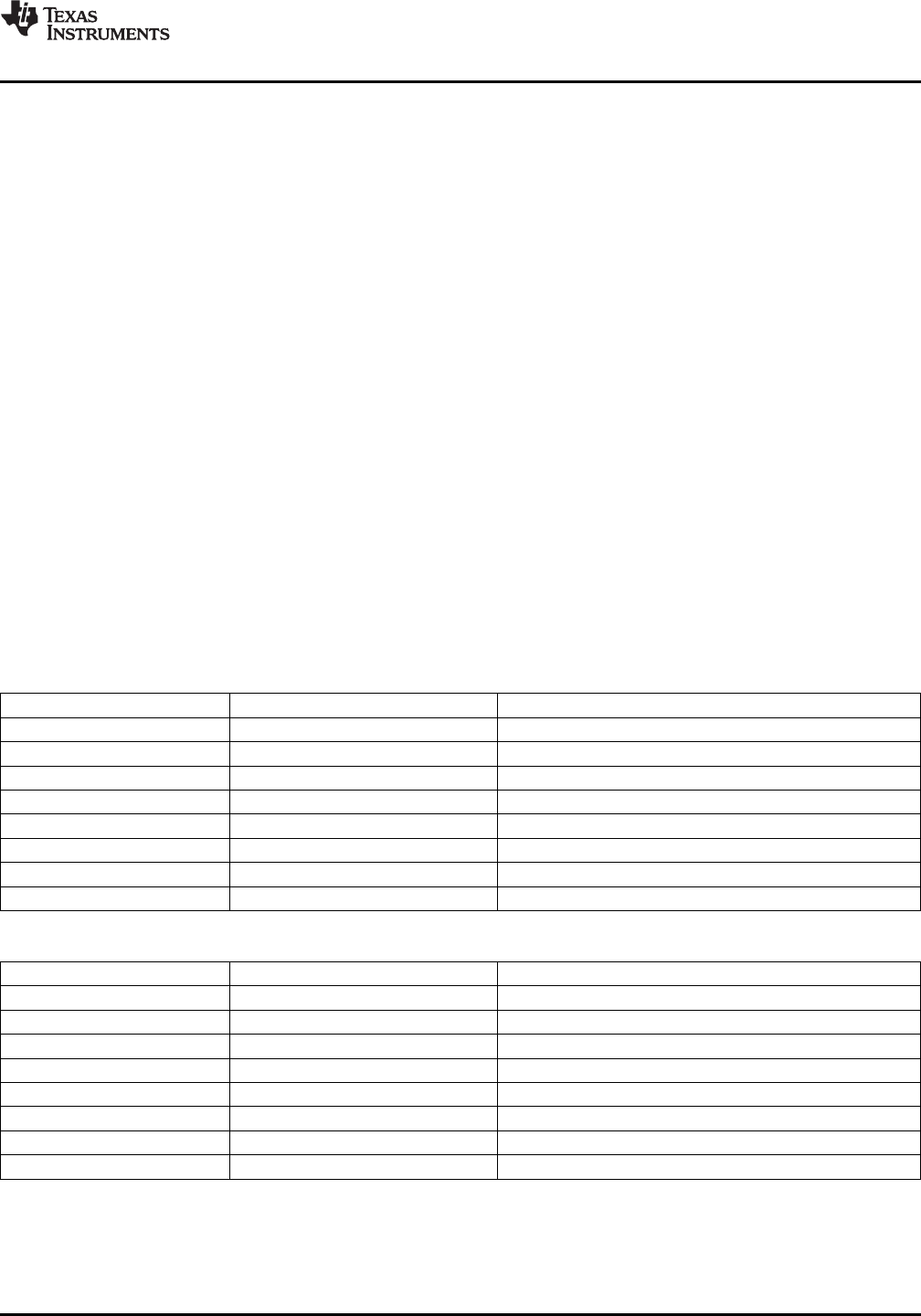Datasheet
Table Of Contents
- 1 Digital Media System-on-Chip (DMSoC)
- Table of Contents
- 2 Revision History
- 3 Device Overview
- 3.1 Device Characteristics
- 3.2 Device Compatibility
- 3.3 ARM Subsystem
- 3.3.1 ARM926EJ-S RISC CPU
- 3.3.2 CP15
- 3.3.3 MMU
- 3.3.4 Caches and Write Buffer
- 3.3.5 Tightly Coupled Memory (TCM)
- 3.3.6 Advanced High-Performance Bus (AHB)
- 3.3.7 Embedded Trace Macrocell (ETM) and Embedded Trace Buffer (ETB)
- 3.3.8 ARM Memory Mapping
- 3.3.9 Peripherals
- 3.3.10 PLL Controller (PLLC)
- 3.3.11 Power and Sleep Controller (PSC)
- 3.3.12 ARM Interrupt Controller (AINTC)
- 3.3.13 System Module
- 3.3.14 Power Management
- 3.4 DSP Subsystem
- 3.5 Memory Map Summary
- 3.6 Pin Assignments
- 3.7 Terminal Functions
- 3.8 Device Support
- 3.9 Documentation Support
- 3.10 Community Resources
- 4 Device Configurations
- 4.1 System Module Registers
- 4.2 Power Considerations
- 4.3 Clock Considerations
- 4.4 Boot Sequence
- 4.5 Configurations At Reset
- 4.6 Configurations After Reset
- 4.7 Multiplexed Pin Configurations
- 4.7.1 Pin Muxing Selection At Reset
- 4.7.2 Pin Muxing Selection After Reset
- 4.7.3 Pin Multiplexing Details
- 4.7.3.1 PCI, HPI, EMIFA, and ATA Pin Muxing
- 4.7.3.2 PWM Signal Muxing
- 4.7.3.3 TSIF0 Input Signal Muxing (Serial/Parallel)
- 4.7.3.4 TSIF0 Output Signal Muxing (Serial/Parallel)
- 4.7.3.5 TSIF1 Input Signal Muxing (Serial Only)
- 4.7.3.6 TSIF1 Output Signal Muxing (Serial Only)
- 4.7.3.7 CRGEN Signal Muxing
- 4.7.3.8 UART0 Pin Muxing
- 4.7.3.9 UART1 Pin Muxing
- 4.7.3.10 UART2 Pin Muxing
- 4.7.3.11 ARM/DSP Communications Interrupts
- 4.7.3.12 Emulation Control
- 4.8 Debugging Considerations
- 5 System Interconnect
- 6 Device Operating Conditions
- 7 Peripheral Information and Electrical Specifications
- 7.1 Parameter Information
- 7.2 Recommended Clock and Control Signal Transition Behavior
- 7.3 Power Supplies
- 7.4 External Clock Input From DEV_MXI/DEV_CLKIN and AUX_MXI/AUX_CLKIN Pins
- 7.5 Clock PLLs
- 7.6 Enhanced Direct Memory Access (EDMA3) Controller
- 7.7 Reset
- 7.8 Interrupts
- 7.9 External Memory Interface (EMIF)
- 7.10 DDR2 Memory Controller
- 7.10.1 DDR2 Memory Controller Electrical Data/Timing
- 7.10.2 DDR2 Interface
- 7.10.2.1 DDR2 Interface Schematic
- 7.10.2.2 Compatible JEDEC DDR2 Devices
- 7.10.2.3 PCB Stackup
- 7.10.2.4 Placement
- 7.10.2.5 DDR2 Keep Out Region
- 7.10.2.6 Bulk Bypass Capacitors
- 7.10.2.7 High-Speed Bypass Capacitors
- 7.10.2.8 Net Classes
- 7.10.2.9 DDR2 Signal Termination
- 7.10.2.10 VREF Routing
- 7.10.2.11 DDR2 CK and ADDR_CTRL Routing
- 7.11 Video Port Interface (VPIF)
- 7.12 Transport Stream Interface (TSIF)
- 7.13 Clock Recovery Generator (CRGEN)
- 7.14 Video Data Conversion Engine (VDCE)
- 7.15 Peripheral Component Interconnect (PCI)
- 7.16 Ethernet MAC (EMAC)
- 7.17 Management Data Input/Output (MDIO)
- 7.18 Host-Port Interface (HPI) Peripheral
- 7.19 USB 2.0 [see Note]
- 7.20 ATA Controller
- 7.21 VLYNQ
- 7.22 Multichannel Audio Serial Port (McASP0/1) Peripherals
- 7.23 Serial Peripheral Interface (SPI)
- 7.24 Universal Asynchronouse Receiver/Transmitter (UART)
- 7.25 Inter-Integrated Circuit (I2C)
- 7.26 Pulse Width Modulator (PWM)
- 7.27 Timers
- 7.28 General-Purpose Input/Output (GPIO)
- 7.29 IEEE 1149.1 JTAG
- 8 Mechanical Packaging and Orderable Information

TMS320DM6467T
www.ti.com
SPRS605C –JULY 2009–REVISED JUNE 2012
7.26 Pulse Width Modulator (PWM)
The PWM provides a way to generate a pulse periodic waveform for motor control or can act as a digital-
to-analog converter with some external components.
7.26.1 PWM Device-Specific Information
The 2 DM6467T Pulse Width Modulator (PWM) peripherals support the following features:
• 32-bit period counter
• 32-bit first-phase duration counter
• 32-bit repeat count for one-shot operation. One-shot operation generates N+1 periods of waveform, N
being the repeat count register value.
• Configurable to operate in either one-shot or continuous mode
• Programmable buffered period and first-phase duration registers
• One-shot operation triggerable by VPIF or GPIO with programmable edge transitions. (low-to-high or
high-to-low).
• One-shot operation generates N+1 periods of waveform, N being the repeat count register value
• Configurable PWM output pin inactive state
• Interrupt and EDMA synchronization events
• Emulation support for stop or free-run operation
7.26.2 PWM Peripheral Register Description(s)
Table 7-136 and Table 7-137 show the register memory maps for PWM0/1.
Table 7-136. PWM0 Register
HEX ADDRESS RANGE ACRONYM REGISTER NAME
0x01C2 2000 PID PWM0 Peripheral Identification Register
0x01C2 2004 PCR PWM0 Peripheral Control Register
0x01C2 2008 CFG PWM0 Configuration Register
0x01C2 200C START PWM0 Start Register
0x01C2 2010 RPT PWM0 Repeat Count Register
0x01C2 2014 PER PWM0 Period Register
0x01C2 2018 PH1D PWM0 First-Phase Duration Register
0x01C2 201C - 0x01C2 23FF - Reserved
Table 7-137. PWM1 Register Memory Map
HEX ADDRESS RANGE ACRONYM REGISTER NAME
0x01C2 2400 PID PWM1 Peripheral Identification Register
0x01C2 2404 PCR PWM1 Peripheral Control Register
0x01C2 2408 CFG PWM1 Configuration Register
0x01C2 240C START PWM1 Start Register
0x01C2 2410 RPT PWM1 Repeat Count Register
0x01C2 2414 PER PWM1 Period Register
0x01C2 2418 PH1D PWM1 First-Phase Duration Register
0x01C2 241C -0x01C2 27FF - Reserved
Copyright © 2009–2012, Texas Instruments Incorporated Peripheral Information and Electrical Specifications 337
Submit Documentation Feedback
Product Folder Link(s): TMS320DM6467T










